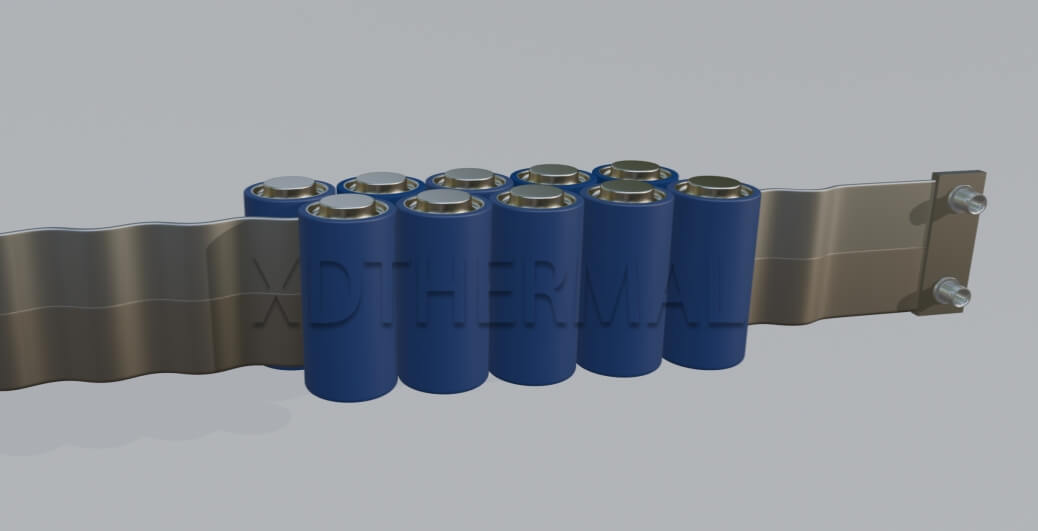You need a liquid cold plate in a specific size — ideally something ready to go. But without a perfect match, delays and unexpected costs loom. The good news? Even without a warehouse full of ready-to-ship plates, you can still secure a fast, cost-effective solution.

Let’s break down how “off-the-shelf” works in the B2B cold plate world — and when a custom approach remains the smartest path.
In the liquid cold plate industry, “off-the-shelf” is more about design reuse than ready-made stock. Think pre-existing tooling and adaptable designs, not mass-produced inventory.
Our liquid cold plates are primarily custom-designed for each customer’s application. Dimensions, channel layout, inlet/outlet positions, and structure are developed to fit your battery module’s size, layout, and cooling demands. While we don’t store standard products, we can reference existing project samples close to your required size and adapt them — reducing engineering time, tooling costs, and lead time compared to starting from zero.
An “off-the-shelf” cold plate in our context means using proven designs from past EV, ESS, or solar projects that share your dimensional and functional requirements. Even if not an exact match, CNC trimming, machining inlet ports in new positions, or modifying channel ends can make it fit your system. This approach keeps the proven thermal performance of an existing plate while adapting the fit.
If your project shares characteristics with common industry pack formats, reusing an existing cold plate design is both practical and economical.
Popular pack sizes — such as 1200×900 mm EV battery modules or standardised ESS rack units — often match past designs in our library. Small modifications can bring them within tolerance, avoiding new mould development.
We maintain over 300 project references, covering a wide range of sizes and cooling capacities. For example, if you need a cold plate for a 1260×960 mm EV module, and we already have a plate for 1255×945 mm, a CNC adjustment to edges and inlet positions may suffice. This not only speeds production but also uses a design with proven performance data, reducing testing and validation risks.
Not every requirement can be met by reusing an existing design, especially for applications with unique geometry or extreme thermal performance demands.
If your battery pack uses an unusual cell format, has very high cooling demands, or must meet stringent weight limits, a fully custom solution is often unavoidable.
For example, flying car battery systems require ultra-thin plates (sometimes under 5 mm) with precision flow paths to handle high-altitude cooling challenges. ESS installations in deserts may need reinforced channels for higher pressure coolant systems and corrosion-resistant coatings. In these cases, even if dimensions match a past plate, the working environment and coolant type make a fresh design essential.
The choice of manufacturing process greatly influences whether a plate can be adapted from an existing design or must be fully custom.
We work with brazing stamping, aluminium extrusion welding, CNC machining, and other methods to meet diverse technical and budget requirements. Each process offers different flexibility levels for design adaptation.
● Brazing stamping: Excellent for high-volume production with repeatable quality; suitable for adapting channel patterns if tooling exists.
● Aluminium extrusion welding: Offers strong structural integrity; extrusion dies can be reused with length adjustments.
● CNC machining: Highest flexibility for low-volume customisation; ideal for modifying an existing plate to match new port positions or mounting features.
By having these capabilities in-house, we can recommend the most time- and cost-efficient approach depending on whether your size is close to a past design.
Leveraging existing moulds and tooling can deliver dramatic savings in both cost and delivery schedules.
Using a near-fit mould can cut tooling investment by up to 80% and reduce lead times by 4–6 weeks, making it easier to meet aggressive project deadlines.
Tooling costs for cold plates typically range from USD 5,000 to 30,000. When reusing an existing tool, you only pay for minor modifications, not a full build. For a project with tight validation schedules, this can mean the difference between hitting a product launch window or missing it.
At XD THERMAL, we specialise in both full custom designs and adapted solutions, backed by over 300 successful cases across EV, ESS, and renewable energy markets.
Our process starts by evaluating your required size and technical needs, checking our project database for similar designs, and adapting them if possible. If no match exists, we offer fast-track customisation.
If your request matches an existing plate, we can adjust it via CNC machining or minor tooling tweaks. If not, we evaluate your supplied data — such as target dimensions, module layout, cooling capacity, and any thermal simulation results — to design a plate from scratch. Even for new designs, our in-house extrusion line, brazing facilities, and machining centres mean we can move from drawings to prototypes quickly, often in under four weeks.
The more complete your initial specifications, the faster we can match you to an existing design or develop a new one.
Providing accurate dimensions, 2D/3D drawings, coolant type, flow rate, and target temperature range enables a precise technical evaluation from day one.
For best results, share:
● Target cold plate size and tolerances
● Module or cell layout (e.g., prismatic, cylindrical, pouch)
● Cooling capacity per plate in watts or kilowatts
● Coolant type (water-glycol, dielectric fluid, etc.)
● Any thermal simulation data
● Structural or weight constraints
With this information, we can confirm within days whether an existing design can be adapted, or if a custom plate is needed.
While true off-the-shelf cold plates are rare, XD THERMAL’s extensive design library and flexible manufacturing make finding or adapting a near match both fast and cost-effective.